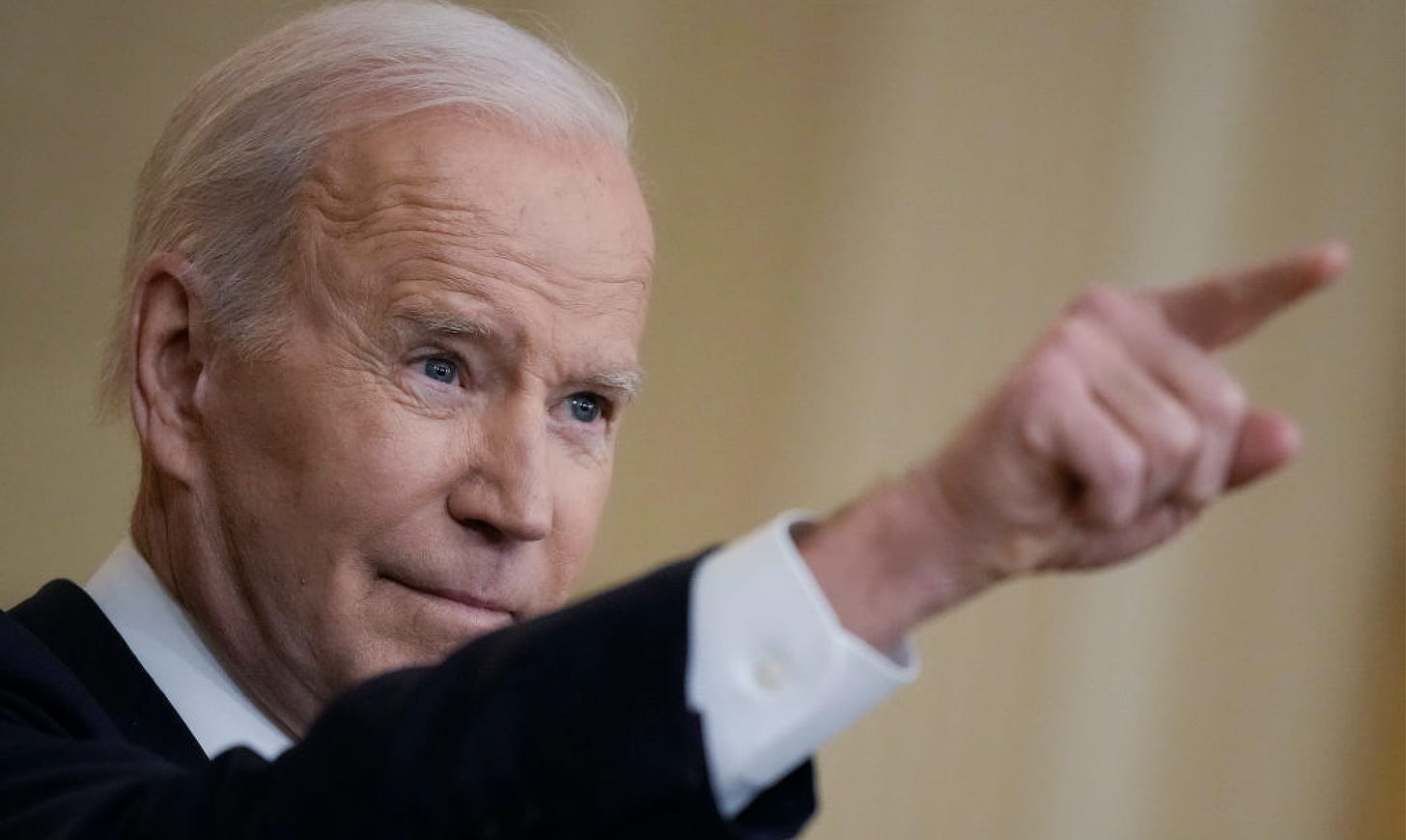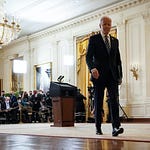Please consider subscribing for $6 a month to support fearless media commentary. Thanks!
Stay healthy.
Be kind.
Btw, you can now also read PRESS RUN using the new Substack app for iPhone.
On the eve of Ukraine president Volodymyr Zelensky’s address to Congress on Wednesday, White House press secretary Jen Psaki was asked no fewer than six times at the daily press briefing if the Biden administration would grant Zelensky’s military request of creating a “no-fly zone” over the bombarded country.
Ever since Russia invaded, the administration has made clear there’s no chance that the U.S. or NATO is going to create a no-fly zone, because that would mean direct warfare with a nuclear power inside Russia.
“First thing that we would do in order to establish a no-fly zone over Ukraine would be to send the U.S. military to attack military units inside Russia--the anti-aircraft batteries that are there, the anti-aircraft artillery,” Democratic Congressman Jim Himes recently explained. “United States Air Force planes would be killing thousands of Russian military members inside Russia."
Especially because Putin appears to be increasingly unstable in the decisions he’s making, a no-fly zone is not going to happen. The U.S. previously created no-fly zones over Iraq, Libya, and Serbia during times of crisis. None of those countries had an arsenal of nuclear missiles. They were also extraordinarily complex operations.
“When the U.S. and United Kingdom imposed no-fly zones in the south (to protect Shiites) and the north (to protect Kurds), American combat planes flew over 200,000 sorties and dropped more than 1,000 bombs on more than 240 targets,” Slate recently noted.
Yet for three weeks, the press has been relentless in asking the same question over and over, even though White House responses each time have been an unequivocal, no. A few of the inquiries from Tuesday’s session:
• “Has the administration’s thinking shifted on that at all?”
• “To put it bluntly, is Zelensky wasting his time tomorrow asking for these things?”
• “How does the President plan to continue being, like, a voice of restraint in these situations and holding back some of those requests?”
The media inquiries are usually framed as President Joe Biden not doing enough to help Ukrainians; that he represents “restraint” in the face of human suffering. After piling on Biden following the U.S. troop withdrawal from Afghanistan, the Beltway media — echoing GOP talking points — seem anxious to put the White House on the defensive, again.
When two dozen “foreign policy elites” signed an open letter advocating a no-fly zone, Politico’s Playbook ran the story as big news, trumpeting it as the day’s most important item. Later that week, when 78 experts signed a letter opposing a no-fly zone, Politico buried the item.
On March 7, CNN anchor Brianna Keilar compared the lack of a no-fly zone to the “bare minimum” countries like Britain and France did at the start of World War II. But Hitler’s Germany didn’t have 1,500 nuclear warheads deployed on strategic long-range systems and almost 3,000 more in reserve, the way Putin’s Russia does today.
The media chatter continues to be incessant. “No-fly zone” has been mentioned more than 700 times on cable news since the invasion began, according to TVeyes.
What explains this obsession? Why do reporters and pundits think there’s a chance Biden would change his mind and risk nuclear war? Why do they present the no-fly zone as a reasonable option? (They’re not constantly asking if Biden is going to send tens of thousands of U.S. troops to fight Russians inside Ukraine.) And why do journalists constantly, and recklessly, omit crucial context surrounding the topic?
Interviewing Americans about the invasion and what the U.S. should be doing to help Ukrainians, the New York Times this week quoted a Michigan voter saying she’s been unhappy with the Ukraine response so far and is in favor of establishing a no-fly zone. “I truly believe that [the U.S.] could be doing more to help,” she said. The Times made no mention that guarding the Ukrainian skies could spark a nuclear war.
Truth is, most Americans have no idea what a Ukraine no-fly zone would mean militarily, simply because the media have not educated them. When Americans do find out, their support for the strategy drops dramatically.
“A broad bipartisan majority of Americans think the United States should stop buying Russian oil and gas and work with NATO to set up "no-fly zones" to protect Ukraine from Russian air strikes,” Reuters announced last week, trumpeting its “exclusive” polling results. The findings were framed as bad news for the White House: “That puts pressure on U.S. President Joe Biden to take more aggressive actions against Moscow.”
The report though, came with a boulder-sized caveat: “It was not clear if respondents who supported a no-fly zone were fully aware of the risk of conflict.”
Oh.
A subsequent CBS poll found that “Support for a no-fly zone … drops off considerably when people are asked if it meant U.S. forces might have to engage Russian aircraft, and be considered an act of war by Russia.” U.S support for the move dropped from 59 percent to 38 percent, once people were given proper context. We don’t know how big the drop would be if CBS had specifically spelled out that a no-fly zone could lead to nuclear annihilation.
The no-fly zone isn’t going to happen, and for valid reasons. The press needs to stop playing gotcha with the White House.
(Photo: Drew Angerer/Getty Images)
GOOD STUFF:
The brutal invasion continues to generate bouts of heroic journalism.
From Vanity Fair’s, ““This Is Personal for Them”: Two Ukrainian AP Journalists Capture the Most Devastating Moments of War”:
In Mariupol, Ukraine, two Associated Press journalists, Evgeniy Maloletka and Mstyslav Chernov, have captured the most devastating realities of Russia’s war. Their photographs are not only a record of the utter destruction, but a direct rebuttal to the Kremlin’s propaganda, giving the world a window into the lives destroyed every day as Russia pushes further into the country, attacking civilian targets. It was Maloletka who captured the bloodied, pregnant woman being taken from the bombed maternity hospital on a stretcher; ”one of the most iconic images of this war so far,” AP executive editor Julie Pace tells Vanity Fair.
FUN STUFF — BECAUSE WE ALL NEED A BREAK
War on Drugs, “I Don’t Live Here Anymore”
The pride of Philadelphia, Adam Granduciel’s band continues to expand and impress as he details our stumbles through life, wrapped in a majestic sound. This is the second single from the band’s latest album by the same name.
When I think about the old days, babe
You're always on my mind
I know it ain't like I remember
I guess my memories run wild
🎙 Click here to listen to the music that’s been featured on PRESS RUN, via Apple Music.















The media's reckless "no-fly zone" coverage